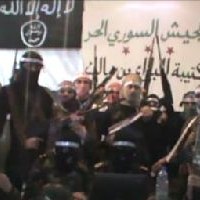![]()
Thu, Jan 24, 2013 | MEForum | by Aymenn Jawad Al-Tamimi
Originally published in The American Spectator.
Recently a video emerged in which pro-Assad militiamen can be seen beating and shooting a prisoner to death. What might seem remarkable is that the militiamen are insulting Islam in the process, mocking the takbir — that is, the cry of “Allahu akbar” — the Islamic conception of paradise for martyrs. In the first half of the video, one of the executioners — disparaging Muhammad — shouts, “F–k you and your prophet.” Later, another of them yells, “Damn your God.”
It may come across as odd that pro-Assad militiamen would disparage the Islamic religion in such a crude manner, but it should be noted that there are many videos like this in which the anti-Islamic sentiment takes a more subtle form.
Thus throughout in the course of the civil war there have been some videos of regime loyalists beating detainees and insisting that they proclaim that “there is no god except Bashar,” which reflects not so much cult-worship of Assad as a mockery of the Shahadah (Muslim declaration of faith, of which the first part goes “There is no deity but God”).
A particularly striking observation is that these videos invariably show pro-Assad militiamen whose accents illustrate that they are Alawites. It may seem odd that Alawites — most frequently described in media reports as either an offshoot of Shi’ite Islam or simply a sect of Shi’ism — would disparage Islam, but an examination of the history of Alawite identity in Syria will demonstrate that such an attitude towards Islam among pro-Assad Alawite militiamen and soldiers comes as no surprise at all.
Until around the 1920s, Alawites were known to outsiders by the term “Nusayris” — named after Muhammad ibn Nusayr, the reputed founder of the sect in 9th-century Iraq — and they identified themselves by this name, content with a separate ethnic and religious identity that was essentially a “neither Shi’ite or Sunni” position, stemming from the highly syncretic nature of the traditional faith.
Beginning with the establishment of the French Mandate in Syria and increasing contact with the outside world beyond the traditional rural homelands in the northwest mountains, several writers from the community began to emphasize that they were not “Nusayris” (a term they rejected as an invention of the sect’s enemies), but Alawites, emphasizing a supposed connection with mainstream Islam and Shi’ism in particular.
Yet when it came to the question of whether the “Alawite State” would be united with the rest of the Mandate to form Syria, five Alawite community leaders — including Bashar’s grandfather — went to great lengths in a memorandum to the French Prime Minister in 1936 to emphasize distinctness from Islam, even as they consistently employed the term “Alawite” to describe themselves. Thus they affirmed that Alawites are considered “infidels” under Islam, and that a spirit of “fanaticism” is nurtured in Islam against non-Muslims.
Despite some attempts by Shi’ite clergy in Najaf in the middle of the 20th century to reach out to Alawites and bring them closer to the fold of mainstream Twelver Shi’ite Islam, the fact is that since the end of the French Mandate in 1946, Alawism in Syria has come to be less associated with identification with an actual religion and more with a simple bloodline identity, just as many Jews might practice no religion at all but nonetheless identify as ethnically Jewish.
This transition was the result of two factors. First, there was the rise of pan-Arab Ba’athist ideology, which according to Ba’ath party founder Michel Aflaq (a Greek Orthodox Christian) stipulated that Islam and Arabism should be inherently bound, but in practice translated to separation from a religious identity and served as an alternative for many Alawites seeking to advance themselves in the Syrian state.
Hence, even before the advent of the Assad dynasty, an Alawite officer named Ibrahim Khalas could write an article in 1967 disparaging religion and God as concepts to be confined to the dustbin of history, and trigger outrage from Sunni Muslim and Christian religious leaders, but not arouse a similar reaction in the Alawite community.
Further, the ascent of the Assad dynasty with Bashar’s father Hafez being made president in 1970 led to a two-fold policy of (i) declaring that Alawites were nothing more than Twelver Shi’ites and (ii) implementing a process described by Joshua Landis as “Sunnification.” The latter meant trying to demonstrate that in religious practice Alawites were no different from orthodox Sunnis, with a number of mosques built in predominantly Sunni towns.
State propaganda has been keen to portray the Assads as pious Muslims, with outlets like Syrian Arab News Agency (SANA) always hailing the occasion on which the president prays in a prominent mosque to mark a Muslim festival. In fact, contemporary images of Bashar even emphasize how he prays in the Sunni manner, with his lower arms folded in prayer rather than by his sides as happens in the Shi’ite manner of prayer.
This policy was successful in convincing many Iraqi Shi’ites who worked in Syria that Alawites were simply fellow Shi’ites, even though Alawites have often been deemed by orthodox Twelvers in Iraq as “ghulat” — Arabic for “extremist” — on account of what is seen as veneration of Ali as a deity in the traditional Alawite faith. Conversely, many Sunnis in Syria came to see Bashar as a fellow Sunni — a perception strengthened by the fact that his wife Asma is Sunni.
Even so, the “Sunnification” was no more than cosmetic in terms of the Alawites’ actual religious beliefs, and if anything only succeeded in distancing more of them from religion in general. The result is that there are many Alawites in Syria in particular who simply deem religion in general to be ridiculous, and are thus atheists, even if the issue of bloodline may seem important to them.
Thus it should not be so shocking or incredible to see videos of pro-Assad Alawite militiamen and soldiers ridiculing Islam as they torture Sunni detainees. Indeed, with the constant emphasis by the Assad regime on a narrative of a jihadist opposition from the beginning of the unrest in Syria, hostility to Islam in line with the attitudes expressed by Bashar’s grandfather is not to be unexpected.
This anti-Islamic hostility in turn lends credence to the narrative of jihadist groups that the Assad regime and forces aligned with him are “waging war on Islam,” and thus gives legitimacy to the concept of a “defensive jihad” (to be distinguished from “offensive jihad,” which in much of traditional Islamic jurisprudence is the expansion of the domain of Islam through warfare by the caliph) to protect Muslim brethren from persecution.
To reinforce this notion of “defensive jihad,” jihadist groups like the Saudi-backed Salafi jihadist Ahrar al-Sham and the al Qaeda-aligned Jabhat al-Nusra (JAN) are generally avoiding the tendency of militant Islamic organizations in other countries (e.g. the Islamist insurgents in Mali, Somalia, and Iraq, where a concept of “defensive jihad” is tenuous) to overtly brutalize ordinary fellow Muslims, and have devoted some effort to winning popular support with distribution of humanitarian aid, particularly bread.
Indeed, recently Ahrar al-Sham released a propaganda video emphasizing this very aspect of their activities (accompanied by a benign-sounding nasheed) while allegations of looting on the part of groups recognizably operating under the banner of the Free Syrian Army (FSA) in Aleppo have become all too apparent.
In this context, it should be noted, as Twitter user “Syrian_Scenes” (an account well worth following) points out, that Arabic news channel al-Jazeera has routinely misrepresented the likes of JAN, Suqur al-Sham, and Ahrar al-Sham as operating as part of the FSA, when in fact they are clearly separate from such identification.
Indeed, it does not follow from an emphasis on “defensive jihad” that the jihadist groups are maintaining trouble-free relationships with non-jihadist rebels opposed to Assad (or even among each other, for that matter). In fact, the tensions between JAN in particular and other rebel groupings are finally coming to more widespread media attention, with a number of northern rebels interviewed by Martin Chulov of the Guardian already speaking of the need for an Iraq-style Anbar Awakening (a key aspect behind the weakening of al-Qaeda’s power in Iraq from the days of 2005-6) against the likes of JAN.
On occasion, hardline foreign fighters and al-Qaeda supporters have denounced the Free Syrian Army as “apostates” (takfir), contrasting with the complete rejection of takfir on the part of other jihadist groups like Liwaa Islam (hat-tip: “Syrian_Scenes”). JAN has thus far refrained from invoking takfir against ordinary Sunni civilians, but that situation will probably change in a post-Assad environment if it finds people unwilling to accept strict imposition of Islamic law.
In any case, JAN makes its anti-Alawite sentiment clear, referring to Alawites as “Nusayris” — a term that is now considered offensive among Alawites. For instance, in this recent JAN video, the speaker in the middle of the video refers to Assad and the “Nusayri apostates [from Islam].”
In short, the above evidence should illustrate that the notion of a Sunni-Shi’ite conflict is not the only perceived dichotomy at play in the Syrian civil war, significant as that concept is in a number of respects. An Alawite identity mainly based on bloodline but with hostility to Islam is one strand at work here, and jihadist groups in Syria are well aware of it and have exploited it to bolster support for a struggle to overthrow Assad framed as a jihad to defend Islam.
At the same time, one should not be sensationalist and conclude that a jihadist takeover of Syria is imminent after the fall of the Assad regime. At most, I expect jihadist groups to have a foothold in parts of the north and east (particularly Aleppo and Deir ez-Zor) similar to al-Qaeda’s foothold in the northern Iraqi city of Mosul.
Instead, the point is to look beyond single paradigms even when it comes to examining issues like Sunni-Alawite tensions. Further, the personal rivalries among rival rebel groups — jihadist and non-jihadist — are becoming ever more intense, and will make the task of maintaining a united Syria after Assad’s fall all the more difficult.
To paraphrase pundit Michael Weiss, a “civil war within the civil war” beckons, but media commentary has paid insufficient attention to this looming prospect.
Aymenn Jawad Al-Tamimi is a Shillman-Ginsburg Fellow at the Middle East Forum, and a student at Brasenose College, Oxford University.



 RSS
RSS











Latest Comments
Hello Mike, Thank you for your positive feedback to the article. I felt there wasn’t too much critical analysis of ...
Thanks for this considered and well constructed article. A follow up article on the manner in which the editorial contro...
THE CLUELESSNESS OF CLAIMING THAT OBAMA'S MIDDLE EAST POLICIES WERE A FAILURE CANNOT BE FURTHER FROM THE TRUTH, WHAT THE...
As long as Obama is the president of the usa do not trust the us government......
Thank you for an good read....